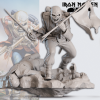75mm scale resin kit. Sculpted by Michael Kontraros. Boxart by Chris Panagiotou. Kit includes 12 kit parts.
"The Trooper" song by the Iron Maiden was released as the second single on 20 June 1983 from the band's fourth studio album, Piece of Mind (1983). It was one of only a few songs to get much radio airplay in the United States, thus peaking at No. 28 on the US Mainstream Rock charts. It also achieved success in the United Kingdom, peaking at No. 12 in the UK Singles Charts as well as gaining a much better reception than the band's previous single, "Flight of Icarus".
Written by bassist and founding member Steve Harris, the song is based on the Charge of the Light Brigade at the Battle of Balaclava 1854, which took place during the Crimean War, and inspired by Lord Tennyson's 1854 poem of the same name. The track has been the subject of much praise since its release, with AllMusic describing it as "an all-time genre classic that boasts guitarists Dave Murray and Adrian Smith's most memorable harmonized lead riff, plus that trademark galloping rhythm," while Mick Wall comments that it is the song "which most Maiden fans from those days still recall first when you mention the Piece of Mind album." Despite the popularity of the song, it was the single's B-Side, a cover of Jethro Tull's "Cross-Eyed Mary", which managed to gain a substantial amount of airplay on US radio, becoming one of the band's few tracks, along with previous single "Flight of Icarus", to do so.
It’s quite an atmospheric song as the opening in “The Trooper” is meant to try and recreate the galloping horses in the charge of the light brigade. The first verses show the soldier’s patriotism: He’s willing to die if he can take an enemy with him. “Run you through” regards various kinds of blades – swords, spears (the presumed weapon of a light cavalryman) and bayonets installed atop the rifles to stab approaching enemies. And as the trooper dies, he feels lonely on the ground and slowly fading to death. Despite this feeling of emptiness and being “forgotten,” he dies without regret or fear.
A regular fixture in the band’s concerts, vocalist Bruce Dickinson has always waved a Union Flag during live performances. And, more recently, has begun wearing an authentic red coat uniform which would have been worn during the battle on which the song was based.
Eddie sheds his tatty jeans-and-T-shirt combo for the first time, changing into a smart red cavalry uniform for arguably his most popular incarnation – the Trooper tattoo taking pride of place on Steve Harris’s forearm. There is something highly stirring about this image of bullish resilience, but Riggsy reckons its appeal is more simple: “I think this is popular because it has a lot of red and blue in it,” insists the artist. “The other covers don’t have much red. I resist using red just for the sake of it (can you put more blood in it Derek… whinge whinge).”
Text Courtesy of Micheal Kontraros Collectables














